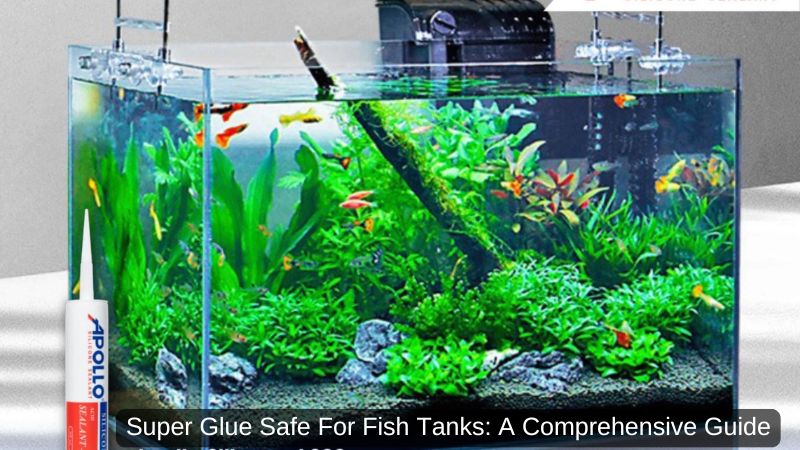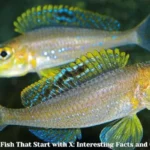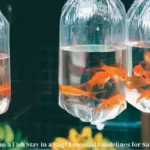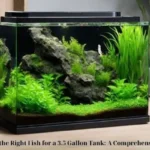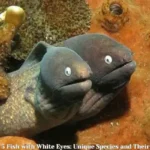Aquarium accessories and decorations
Super Glue Safe For Fish Tanks: A Comprehensive Guide
Super glue, also known as cyanoacrylate adhesive, is a versatile product with a wide range of applications, from household repairs to complex industrial uses. Among its many uses, one of the more niche yet essential applications is in the aquarium hobby. Super glue is widely used in aquascaping, the art of creating beautiful underwater landscapes in fish tanks. But many aquarists often wonder: Is super glue safe for fish tanks? This article Elegant Aquariums will explore the safety of using super glue in aquariums, its benefits, how to use it properly, and the types of glue that are best suited for this purpose.
Understanding Super Glue and Its Composition
Super glue is primarily composed of cyanoacrylate, a fast-acting adhesive that bonds almost instantly when exposed to moisture. Cyanoacrylate polymerizes (forms chains of molecules) rapidly when it comes into contact with water, making it ideal for a range of applications where quick bonding is needed. This property of super glue is particularly useful in aquariums where quick and strong bonding is required to attach plants, corals, or decorations.
Cyanoacrylate adhesives come in various forms, including liquid, gel, and paste, each suited for different types of applications. In aquascaping, gel forms are often preferred because they provide more control during application, especially when working underwater.
Is Super Glue Safe for Fish Tanks?

The primary concern for aquarists when using any adhesive in a fish tank is whether it can harm the aquatic life. Fortunately, super glue is considered safe for use in aquariums, provided it is 100% cyanoacrylate. When super glue dries, it becomes completely inert, meaning it does not leach harmful chemicals into the water, making it safe for fish, plants, and other aquatic organisms.
The safety of super glue in fish tanks has been well-documented through years of use by both amateur and professional aquarists. It is commonly used to attach coral fragments in marine tanks, secure plants in freshwater aquariums, and bond decorations or structures together.
Benefits of Using Super Glue in Aquariums
Versatility in Application
One of the major advantages of super glue is its versatility. It can bond a wide variety of materials, including plastic, metal, wood, and rock. This makes it ideal for use in aquariums, where different materials are often used for decorations and plant anchors. Whether you need to attach a moss to driftwood, secure a plant to a rock, or repair a broken decoration, super glue can handle the task.
Fast and Strong Bonding
Super glue’s fast bonding properties are particularly beneficial in an aquarium setting, where you might need to attach items underwater or in damp conditions. The glue sets within seconds, allowing you to place the item in the desired location without the need to wait for a long curing period. Once set, the bond is extremely strong, providing long-lasting results even in a water-filled environment.
Safe for Aquatic Life
As mentioned earlier, once super glue cures, it becomes inert and safe for all aquatic life. This includes fish, invertebrates, and plants. Many reef keepers use cyanoacrylate-based glue to attach corals to live rock, knowing it will not harm the delicate ecosystem within the tank. Similarly, freshwater aquarists use it to secure plants without worrying about potential toxicity.
Easy to Use
Super glue is easy to apply and requires no special tools or preparation. This simplicity makes it a favorite among aquarists who need a reliable adhesive for quick fixes or detailed aquascaping projects. Additionally, it can be used both outside and inside the tank, making it incredibly convenient.
How to Properly Use Super Glue in Aquariums
While super glue is safe and effective for aquarium use, proper application is key to achieving the best results. Here’s a step-by-step guide on how to use super glue in your fish tank:
Preparing the Surface
Before applying super glue, ensure that the surfaces you intend to bond are clean and free of debris. If you’re attaching plants, make sure they are free of algae or dirt. For decorations or rocks, a quick rinse can remove any dust or particles that might interfere with the bond.
Applying the Glue
If you’re working with plants or corals, apply a small amount of super glue to the base of the plant or coral. For larger items like rocks or decorations, you can apply the glue directly to the surface. A gel form of super glue is often preferred as it allows for more control and reduces the chances of the glue spreading to unwanted areas.
Securing the Item
Press the item gently onto the desired surface. Hold it in place for a few seconds to allow the glue to set. If you’re working underwater, you may notice the glue curing almost instantly due to the presence of water. This quick curing time is one of the reasons why super glue is so effective in aquascaping.
Curing Time
Although super glue sets quickly, it’s a good idea to give it a few minutes to fully cure before moving the bonded items. Once cured, the bond is strong and can withstand the conditions in the aquarium.
Post-Application Care
After applying the glue, it’s important to monitor the bonded area to ensure it remains secure. Over time, algae growth or other factors might weaken the bond, so occasional reapplication might be necessary, especially in high-flow areas of the tank.
Types of Super Glue Suitable for Aquariums
Not all super glues are created equal, and when it comes to aquariums, it’s essential to choose the right type. Here are some options:
Cyanoacrylate Gel
As mentioned earlier, cyanoacrylate gel is ideal for aquarium use because of its thicker consistency, which provides better control during application. Brands like Gorilla Super Glue Gel and Loctite Super Glue Gel are popular choices among aquarists for their reliability and ease of use.
Reef-Safe Super Glues
For marine tanks, especially those with delicate coral ecosystems, reef-safe super glues are recommended. These glues are specifically formulated to be safe for use in reef environments and are trusted by many reef keepers. Examples include BRS Extra Thick Gel Super Glue and Seachem Reef Glue.
Aquarium-Specific Adhesives
There are adhesives specifically designed for aquarium use, such as Fluval’s Plant & Shrimp Stratum Glue. These products are formulated to be safe for both freshwater and marine tanks, offering a reliable solution for aquascaping projects.
Common Misconceptions About Super Glue in Aquariums
Despite its widespread use, there are some misconceptions about the safety and effectiveness of super glue in aquariums. Let’s address a few of these:
Super Glue is Toxic to Fish
One common myth is that super glue is toxic to fish. However, as discussed, cyanoacrylate glue becomes inert once cured and poses no risk to fish or other aquatic life. It is crucial, though, to ensure the glue is fully cured before introducing it to the tank.
Super Glue Doesn’t Work Underwater
Another misconception is that super glue doesn’t work underwater. On the contrary, cyanoacrylate glue cures even faster in the presence of water, making it highly effective for underwater applications. This property makes it an excellent choice for attaching plants, corals, and decorations directly within the tank.
Super Glue is Only for Small Repairs
While super glue is indeed effective for small repairs, it’s also incredibly versatile and can be used for more extensive aquascaping projects. Whether you’re creating complex underwater structures or simply securing plants, super glue offers a reliable solution.
Alternatives to Super Glue in Aquariums
While super glue is a popular choice, it’s not the only adhesive available for aquarium use. Here are some alternatives:
Epoxy Putty
Epoxy putty is another popular adhesive used in aquariums, particularly for bonding larger structures or filling gaps. It is often used in marine tanks to secure live rock or create stable foundations for corals. Epoxy putty is safe for both freshwater and saltwater tanks once fully cured.
Silicone Sealant
Silicone sealant is commonly used for sealing leaks in aquariums, but it can also be used for bonding. It’s flexible, waterproof, and safe for aquatic life once cured. However, silicone requires a longer curing time compared to super glue, which might be a drawback for some aquarists.
Aquarium Safe Gel Adhesives
Some manufacturers offer gel adhesives specifically designed for aquariums. These products often combine the ease of use of super glue with additional properties like flexibility and resistance to water flow. They are a good option for aquarists looking for a specialized solution.
Conclusion
Super glue, particularly cyanoacrylate-based adhesives, is a safe and effective tool for a wide range of applications in aquariums. From attaching plants to securing decorations and repairing broken items, super glue offers a versatile solution that is both easy to use and reliable. Its safety for aquatic life, fast bonding properties, and ability to work underwater make it an essential tool for any aquarist.
Whether you are a seasoned aquascaper or a beginner looking to enhance your tank, super glue can help you achieve your goals with ease. By understanding the proper techniques for its use and choosing the right type of super glue, you can ensure that your aquarium remains a safe and beautiful environment for your aquatic life.

